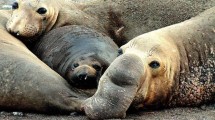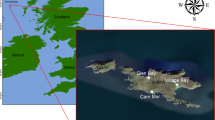Abstract
Individual specialisation is widespread and can affect a population’s ecological and evolutionary dynamics. Whether intra-specific niche differences can influence reproductive investment was examined in a marine mammal, the southern elephant seal (Mirounga leonina), whose females were known to forage in two different areas during the austral winter. The study was conducted at Kerguelen Islands (49°21′S, 70°18′E), southern Indian Ocean, in late winter–early spring 2006. Pups were used as proxies of their mothers’ biology and combined information on their weaning mass (a proxy of females’ foraging success and short-term fitness) together with their blood δ13C value (a proxy of female foraging zone). First, the use of isotopic signature of pups was validated to study the female foraging ecology during their pre-breeding trip by demonstrating that δ13C and δ15N values of pups and their mothers were positively and linearly correlated. Then, blood samples were taken from a large number of newly-weaned pups, which were also weighed, to provide information at the population level. Estimated δ13C values of female seals encompassed a large range of values (from −23.7 to −19.1‰) with an unimodal frequency distribution, suggesting no contrasted foraging areas within the population. No significant relationship was found between pup weaning mass and their carbon signature, indicating no link between female foraging areas and maternal foraging success and investment. Finally, blood δ13C and δ15N values gave new insights into southern elephant seal ecology, suggesting that females mainly foraged north of the Polar Front where they preyed upon myctophid fish in late winter.




Similar content being viewed by others
References
Annett CA, Pierotti R (1999) Long-term reproductive output in western gulls: consequences of alternate tactics in diet choice. Ecology 80:288–297
Arnbom T, Fedak MA, Boyd IL, McConnell BJ (1993) Variation in weaning mass of pups in relation to maternal mass, postweaning fast duration, and weaned pup behaviour in southern elephant seals (Mirounga leonina) at South Georgia. Can J Zool 71:1772–1781
Arnbom T, Fedak MA, Boyd IL (1997) Factors affecting maternal expenditure in southern elephant seals during lactation. Ecology 78:471–483
Aurioles D, Koch PL, Le Bœuf BJ (2006) Differences in foraging location of Mexican and Californian elephant seals: evidence from stable isotopes. Mar Mamm Sci 22:326–338. doi:10.1111/j.1748-7692.2006.00023.x
Bailleul F, Charrassin JB, Ezraty R, Girard-Ardhuin F, McMahon CR, Field IC et al (2007a) Southern elephant seals from Kerguelen Islands confronted by Antarctic Sea ice. Changes in movements and in diving behaviour. Deep Sea Res Part II Top Stud Oceanogr 54:343–355. doi:10.1016/j.dsr2.2006.11.005
Bailleul F, Charrassin JB, Monestiez P, Roquet F, Biuw M, Guinet C (2007b) Successful foraging zones of southern elephant seals from Kerguelen Islands in relation to oceanographic conditions. Philos Trans R Soc B 362:2169–2181. doi:10.1098/rstb.2007.2109
Biuw M, Boehme L, Guinet C, Hindell M, Costa D, Charrassin JB et al (2007) Variations in behavior and condition of a Southern Ocean top predator in relation to in situ oceanographic conditions. Proc Natl Acad Sci USA 104:13705–13710. doi:10.1073/pnas.0701121104
Bolnick DI, Svanbäck R, Fordyce JA, Yang LH, Davis JM, Hulsey CD et al (2003) The ecology of individuals: incidence and implications of individual specialization. Am Nat 161:1–28. doi:10.1086/343878
Bradshaw CJA, Hindell MA, Best NJ, Phillips KL, Wilson G, Nichols PD (2003) You are what you eat: describing the foraging ecology of southern elephant seals (Mirounga leonina) using blubber fatty acids. Proc R Soc Lond B Biol Sci 270:1283–1292. doi:10.1098/rspb.2003.2371
Bradshaw CJA, Hindell MA, Sumner MD, Michael KJ (2004) Loyalty pays: potential life history consequences of fidelity to marine foraging regions by southern elephant seals. Anim Behav 68:1349–1360. doi:10.1016/j.anbehav.2003.12.013
Cherel Y, Hobson KA (2007) Geographical variation in carbon stable isotope signatures of marine predators: a tool to investigate their foraging areas in the Southern Ocean. Mar Ecol Prog Ser 329:281–287. doi:10.3354/meps329281
Cherel Y, Hobson KA, Bailleul F, Groscolas R (2005a) Nutrition, physiology, and stable isotopes: new information from fasting and molting penguins. Ecology 86:2881–2888. doi:10.1890/05-0562
Cherel Y, Hobson KA, Hassani S (2005b) Isotopic discrimination between food and blood and feathers of captive penguins: implications for dietary studies in the wild. Physiol Biochem Zool 78:106–115. doi:10.1086/425202
Cherel Y, Phillips RA, Hobson KA, McGill R (2006) Stable isotope evidence of diverse species-specific and individual wintering strategies in seabirds. Biol Lett 2:301–303. doi:10.1098/rsbl.2006.0445
Cherel Y, Hobson KA, Guinet C, Vanpe C (2007) Stable isotopes document seasonal changes in trophic niches and winter foraging individual specialisation in diving predators from the Southern Ocean. J Anim Ecol 76:826–836. doi:10.1111/j.1365-2656.2007.01238.x
Cherel Y, Ducatez S, Fontaine C, Richard P, Guinet C (2008) Stable isotopes reveal the trophic position and mesopelagic fish diet of female southern elephant seals breeding on Kerguelen Islands. Mar Ecol Prog Ser (in press)
Clutton-Brock TH, Iason GR, Albon SD, Guinness FE (1982) Effects of lactation on feeding behaviour and habitat use in wild red deer hinds. J Zool 198:227–236
Costa DP (1993) The relationship between reproductive and foraging energetics and the evolution of the Pinnipedia. Symp Zool Soc Lond 66:293–314
Das K, Lepoint G, Leroy Y, Bouquegneau JM (2003) Marine mammals from the southern North Sea: feeding ecology data from δ13C and δ15N measurements. Mar Ecol Prog Ser 263:287–298. doi:10.3354/meps263287
de Little SC, Bradshaw CJA, McMahon CR, Hindell MA (2007) Complex interplay between intrinsic and extrinsic drivers of long-term survival trends in southern elephant seals. BMC Ecol 7:3. doi:10.1186/1472-6785-7-3
Field IC, Hindell MA, Slip D, Michael K (2001) Foraging strategies of southern elephant seals (Mirounga leonina) in relation to frontal zones and water masses. Antarct Sci 13:371–379. doi:10.1017/S0954102001000529
Field IC, Bradshaw CJA, Burton HR, Sumner MD, Hindell MA (2005) Resource partitioning through oceanic segregation of foraging juvenile southern elephant seals (Mirounga leonina). Oecologia 142:127–135. doi:10.1007/s00442-004-1704-2
Georges JY, Guinet C (2000) Maternal care in the subantarctic fur seals on Amsterdam Island. Ecology 81:295–308
Golet GH, Kuletz KJ, Roby DD, Irons DB (2000) Adult prey choice affects chick growth and reproductive success in pigeon guillemots. Auk 117:82–91. doi:10.1642/0004-8038(2000)117[0082:APCACG]2.0.CO;2
Guinet C, Jouventin P, Weimerskirch H (1999) Recent population change of the southern elephant seal at Iles Crozet and Iles Kerguelen: the end of the decrease? Antarct Sci 11:193–197. doi:10.1017/S0954102099000255
Herman DP, Burrows DG, Wade PR, Durban JW, Matkin CO, LeDuc RG et al (2005) Feeding ecology of eastern North Pacific killer whales Orcinus orca from fatty acid, stable isotope, and organochlorine analyses of blubber biopsies. Mar Ecol Prog Ser 302:275–291. doi:10.3354/meps302275
Hilderbrand GV, Farley SD, Robbins CT, Hanley TA, Titus K, Servheen C (1996) Use of stable isotopes to determine diets of living and extinct bears. Can J Zool 74:2080–2088. doi:10.1139/z96-236
Hobson KA, Gibbs HL, Gloutney ML (1997a) Preservation of blood and tissue samples for stable-carbon and stable-nitrogen isotope analysis. Can J Zool 75:1720–1723. doi:10.1139/z97-799
Hobson KA, Sease JL, Merrick RL, Piatt JF (1997b) Investigating trophic relationships of pinnipeds in Alaska and Washington using stable isotope ratios of nitrogen and carbon. Mar Mamm Sci 13:114–132. doi:10.1111/j.1748-7692.1997.tb00615.x
Hoelzel AR, Dorsey EM, Stern SJ (1989) The foraging specializations of individual minke whales. Anim Behav 38:786–794. doi:10.1016/S0003-3472(89)80111-3
Jenkins SG, Partridge ST, Stephenson TR, Farley SD, Robbins CT (2001) Nitrogen and carbon isotope fractionation between mothers, neonates, and nursing offspring. Oecologia 129:336–341
Kelly JF (2000) Stable isotopes of carbon and nitrogen in the study of avian and mammalian trophic ecology. Can J Zool 78:1–27. doi:10.1139/cjz-78-1-1
McCann TS, Fedak MA, Harwood J (1989) Parental investment in southern elephant seals, Mirounga leonina. Behav Ecol Sociobiol 25:81–87. doi:10.1007/BF00302924
McMahon CR, Bradshaw CJA (2004) Harem choice and breeding experience of female southern elephant seals influence offspring survival. Behav Ecol Sociobiol 55:349–362. doi:10.1007/s00265-003-0721-1
McMahon CR, Burton HR, Bester MN (2000) Weaning mass and the future survival of juvenile southern elephant seals, Mirounga leonina, at Macquarie Island. Antarct Sci 12:149–153. doi:10.1017/S0954102000000195
Park YH, Gambéroni L (1997) Cross-frontal exchange of Antarctic Intermediate Water and Antarctic Bottom Water in the Crozet Basin. Deep Sea Res Part II Top Stud Oceanogr 44:963–986. doi:10.1016/S0967-0645(97)00004-0
Post DM, Layman CA, Arrington DA, Takimoto G, Quattrochi J, Montaña CG (2007) Getting to the fat of the matter: models, methods and assumptions for dealing with lipids in stable isotope analyses. Oecologia 152:179–189. doi:10.1007/s00442-006-0630-x
Proffitt KM, Garrott RA, Rotella JJ, Siniff DB, Testa JW (2007) Exploring linkages between abiotic oceanographic processes and a top-trophic predator in an Antarctic ecosystem. Ecosystems (N Y, Print) 10:119–126. doi:10.1007/s10021-006-9003-x
Quillfeldt P, McGill RAR, Furness RW (2005) Diet and foraging areas of Southern Ocean seabirds and their prey inferred from stable isotopes: review and case study of Wilson’s storm-petrel. Mar Ecol Prog Ser 295:295–304. doi:10.3354/meps295295
R Development Core Team (2005) R: a language and environment for statistical computing. R Foundation for Statistical Computing, Vienna, Austria. ISBN 3-900051-07-0, URL
Rodhouse PG, Arnbom TR, Fedak MA, Yeatman J, Murray AWA (1992) Cephalopod prey of the southern elephant seal, Mirounga leonina L. Can J Zool 70:1007–1015
Slip DJ (1995) The diet of southern elephant seals (Mirounga leonina) from Heard Islands. Can J Zool 73:1519–1528
Staniland IJ, Reid K, Boyd IL (2004) Comparing individual and spatial influences on foraging behaviour in Antarctic fur seals Arctocephalus gazella. Mar Ecol Prog Ser 275:263–274. doi:10.3354/meps275263
Stephens DW, Krebs JR (1986) Foraging theory. Princeton University Press, Princeton
Trull TW, Armand L (2001) Insights into Southern Ocean carbon export from the δ13C of particles and dissolved inorganic carbon during the SOIREE iron release experiment. Deep Sea Res Part II Top Stud Oceanogr 48:2655–2680. doi:10.1016/S0967-0645(01)00013-3
Watanuki Y, Takahashi A, Sato K (2003) Feeding area specialization of chick-rearing Adélie penguins Pygoscelis adeliae in a fast sea-ice area. Ibis 145:558–564. doi:10.1046/j.1474-919X.2003.00165.x
Acknowledgments
The authors thank fieldworkers who helped collecting samples at Kerguelen, and G. Guillou for stable isotope analysis in France. All research was conducted under the ethics and scientific approval of the Institut Polaire Français Paul Emile Victor (IPEV). The work was supported financially and logistically by the ANR Vulnérabilité IPSOS-SEAL, IPEV (Programme No 109), the Terres Australes et Antarctiques Françaises, and it was a part of the MEOP IPY project.
Author information
Authors and Affiliations
Corresponding author
Additional information
Communicated by J.P. Grassle.
Rights and permissions
About this article
Cite this article
Ducatez, S., Dalloyau, S., Richard, P. et al. Stable isotopes document winter trophic ecology and maternal investment of adult female southern elephant seals (Mirounga leonina) breeding at the Kerguelen Islands. Mar Biol 155, 413–420 (2008). https://doi.org/10.1007/s00227-008-1039-3
Received:
Accepted:
Published:
Issue Date:
DOI: https://doi.org/10.1007/s00227-008-1039-3




